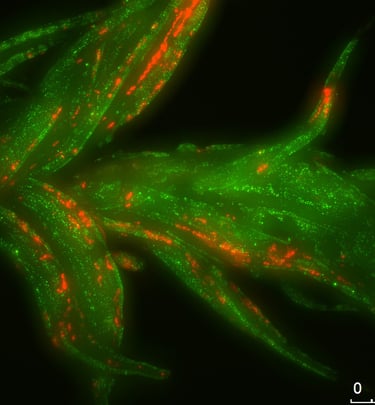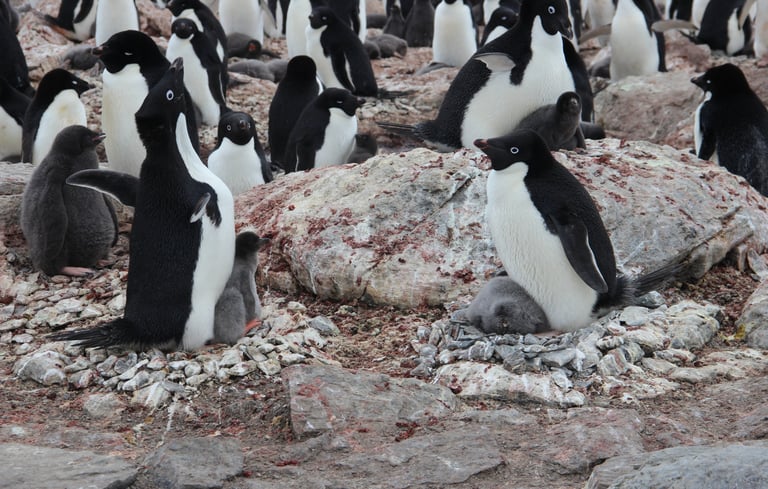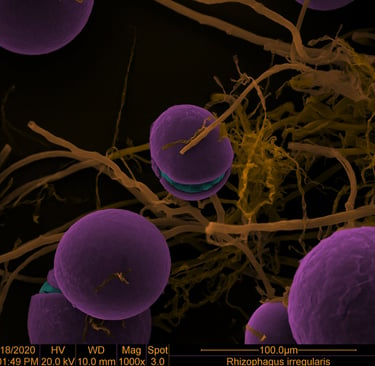
Antarctic microbes
Microbiology
Microorganisms or microbes are the most numerous and diverse lifeforms of terrestrial Antarctica, although they are generally too small to see with the naked eye. These tiny organisms include bacteria, archaea, fungi, single-cellular eukaryotes such as microscopic algae, and viruses. Despite their small size, they play important roles in nutrient cycling, breaking down organic matter, and they form symbiotic relationships with other organisms, for instance mosses and lichens, and help them access nutrients and survive extreme conditions.
Microbes are well adapted to Antarctica’s cold, dry and UV-exposed environments. Some can remain dormant for years, only to become active again once better conditions return. Others form spores to withstand freezing, or produce antifreeze-like substances that help them stay active in sub-zero temperatures. These survival strategies allow microbes to colonize in places where other organisms can’t survive.
History: In the early 20th century, Antarctic explorers Reginald Koettlitz and Edward Wilson, during Scott's Discovery Expedition (1901–1904), collected dark, gelatinous layers from the edges of freshwater ponds. These were later identified as cyanobacterial mats -communities of photosynthetic microbes known as blue-green algae. These century-old samples are preserved at London's Natural History Museum, providing a baseline for contemporary research. Around the same time, during the Swedish Antarctic Expedition (1901–1904), Erik Ekelöf conducted a simple experiment on Snow Hill Island. By exposing petri dishes to the Antarctic air for about two hours, he captured airborne microbes, demonstrating the presence of microorganisms in the continent's atmosphere. It wasn't until 1941 that researchers Darling and Siple systematically isolated and identified various microbes (including bacteria, yeasts, and molds) - from Antarctic snow, soils, water, air, and plant debris. Many more microbes have been discovered since, especially through DNA sequencing methods, although the majority has never been grown or studied in a lab. We are only still starting to understand the full diversity of microbial life in Antarctica.
Microbial habitats
Microbes can be found in nearly any habitat in Antarctica, even in places where no other life can survive, although their activity are closely tied to water availability and temperature. Seemingly lifeless, but microbes can live in ice and snow, in thin liquid layers between snow crystals, where they are active for short periods during the summer. They can even form algal blooms on ice and snow, some of them producing green or pink pigments to protect themselves against UV radiation, making them visible to the naked eye. Antarctic soils, even though often dry and nutrient-poor, support diverse microbial communities, where they can break down organic matter, fix nitrogen and contribute to continued soil formation. In and around meltwater ponds and streams, thick spong-like mats can form consisting of cyanobacteria and other microbes. They are among the most productive ecosystems in Antarctica and create microenvironments for invertebrates like rotifers and tardigrades.
Lichens, mosses and other plants host their own microbiome. These plant-associated microbiomes assist their hosts with nutrient uptake and survival, for instance through producing vitamins or antifreeze proteins. Some microbes have adapted to life inside rocks (endoliths), where they are protected extreme conditions such as high UV radiation and temperature fluctuations.
A special habitat for microbes are geothermal hotspots in Antarctica, for instance on Deception Island. Here, geothermal activity creates hot soils, hot springs, and fumaroles, offering warm refuges in an otherwise rather cold environment. These geothermal areas harbor unique microbial communities, including thermophilic (heat-loving) bacteria and archaea.


Bacteria (cyanobacteria) illuminated as orange dots on moss leaves.


Penguin colonies create hot spots of nutrient rich organic substrate (aka penguin poo) where many microbes thrive and mineralise the organic fecal matter into nutrients that can be used by other organisms. Much of the mineralised nitrogen is blown inland, thereby enriching the vegetation far beyond the physical boundary of the penguin colony.


Fungal hyphae captured under microscope. (photo credit V. Kokkoris)
Want to know more...
A selection of resources on Antarctic microbiology
Varliero, G., Lebre, P. H., Adams, B., Chown, S. L., Convey, P., Dennis, P. G., Fan, D., Ferrari, B., Frey, B., Hogg, I. D., Hopkins, D. W., Kong, W., Makhalanyane, T., Matcher, G., Newsham, K. K., Stevens, M. I., Weigh, K. V. and Cowan, D. A. 2024. Biogeographic survey of soil bacterial communities across Antarctica. Microbiome, 12, 9.
Yergeau, E., Bokhorst, S., Huiskes, A. H. L., Boschker, H. T. S., Aerts, R. and Kowalchuk, G. A. 2007. Size and structure of bacterial, fungal and nematode communities along an Antarctic environmental gradient. FEMS Microbiology Ecology, 59, 436-451
Dennis, P. G., Rushton, S. P., Newsham, K. K., Lauducina, V. A., Ord, V. J., Daniell, T. J., O'Donnell, A. G. and Hopkins, D. W. 2012. Soil fungal community composition does not alter along a latitudinal gradient through the maritime and sub-Antarctic. Fungal Ecology, 5, 403-408.
Newsham, K. K., Hopkins, D. W., Carvalhais, L. C., Fretwell, P. T., Rushton, S. P., O’Donnell, A. G. and Dennis, P. G. 2016. Relationship between soil fungal diversity and temperature in the maritime Antarctic. Nature Climate Change, 6, 182-186.
Many of the above documents are freely available from the publisher websites, but if not, please feel free to reach out to the authors for a copy